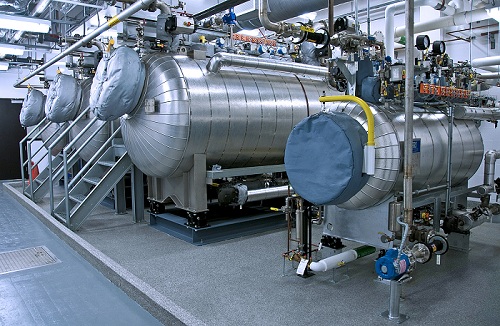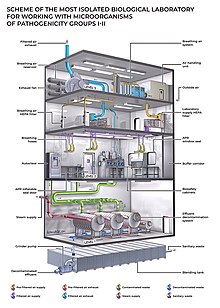160:
processing is offset against the volume of effluent that can be sterilised, as the steam takes up space that could be used to hold effluent. Steam injection is a very noisy process – steam rushing through the effluent can sound like a jet engine. The process can also cause solid material to stick to the sides of the sterilisation tank, which can hinder heat transference from the walls of a jacketed vessel. Low temperature and pressure variants of batch steam injection EDS have been shown capable of decontaminating biosafety level 2 waste by subjecting it to a sterilisation temperature of 82.2 °C. This low temperature requires a long time period of six hours to achieve sterilisation.
100:
139:
is passed through the cavity in the walls of jacketed vessel, raising its temperature of over 121 °C. Once all the effluent has been heated to at least 121 °C for at least 30 minutes, all biologically hazardous material within the kill tank will have been sterilised. At this point, the tank
159:
Batch steam injection systems function similarly to a batch steam EDS, but steam is passed directly through the effluent during the sterilisation stage. This procedure increases the speed at which the effluent can reach the required sterilisation temperature, increasing the throughput time. Speed of
168:
Continuous flow EDS pass liquid effluent through a distance of heated pipework to sterilise it. The heated pipework is frequently coiled to minimise heat loss and the space required. The length and bore of the heated pipework can vary greatly, depending on the rate of flow of the effluent and the
107:
While EDS are designed chiefly to sterilise liquid waste, they can in some instances sterilise solid material carried by the liquid effluent. However the EDS may require grinders to break down the solid materials before they enter site of sterilisation in the EDS, and macerating paddles to stir
282:
Chmielewski, Revis; Day, Michael; Spatz, Stephen; Yu, Qingzhong; Gast, Richard; Zsak, Laslo; Swayne, David (1 December 2011). "Thermal
Inactivation of Avian Viral and Bacterial Pathogens in an Effluent Treatment System within a Biosafety Level 2 and 3 Enhanced Facility".
563:
Chmielewski, Revis; Day, Michael; Spatz, Stephen; Yu, Qingzhong; Gast, Richard; Zsak, Laslo; Swayne, David (December 2011). "Thermal
Inactivation of Avian Viral and Bacterial Pathogens in an Effluent Treatment System within a Biosafety Level 2 and 3 Enhanced Facility".
669:
Cote, Christopher K.; Weidner, Jessica M.; Klimko, Christopher; Piper, Ashley E.; Miller, Jeremy A.; Hunter, Melissa; Shoe, Jennifer L.; Hoover, Jennifer C.; Sauerbry, Brian R.; Buhr, Tony; Bozue, Joel A.; Harbourt, David E.; Glass, Pamela J. (9 July 2020).
198:
in the effluent have been sterilised. After sterilisation, the sterilant must be neutralised before the effluent can discarded into a sewer. As such, a batch chemical EDS requires a large quantity of chemicals, both sterilants and neutralisers, to operate
185:
For smaller scale systems of less than 100 gallons a day, chemical effluent decontamination systems can be used. Effluent is collected in a sterilisation tank, where it is mixed with a chemical sterilant such as
135:, which is a container with hollow walls. Effluent flows into the kill tank either by gravity or through being pumped into the tank. Once the tank is full of effluent, high-temperature pressurised
634:
Trembalay, Gilles; Langer-Curry, Rebecca; Chris, Kiley; Cory, Ziegler (2010). "Effluent
Decontamination Systems: Addressing the Challenges of Planning, Designing, Testing, and Validation".
599:
Trembalay, Gilles; Langer-Curry, Rebecca; Chris, Kiley; Cory, Ziegler (2010). "Effluent
Decontamination Systems: Addressing the Challenges of Planning, Designing, Testing, and Validation".
528:
Trembalay, Gilles; Langer-Curry, Rebecca; Chris, Kiley; Cory, Ziegler (2010). "Effluent
Decontamination Systems: Addressing the Challenges of Planning, Designing, Testing, and Validation".
493:
Trembalay, Gilles; Langer-Curry, Rebecca; Chris, Kiley; Cory, Ziegler (2010). "Effluent
Decontamination Systems: Addressing the Challenges of Planning, Designing, Testing, and Validation".
458:
Trembalay, Gilles; Langer-Curry, Rebecca; Chris, Kiley; Cory, Ziegler (2010). "Effluent
Decontamination Systems: Addressing the Challenges of Planning, Designing, Testing, and Validation".
423:
Trembalay, Gilles; Langer-Curry, Rebecca; Chris, Kiley; Cory, Ziegler (2010). "Effluent
Decontamination Systems: Addressing the Challenges of Planning, Designing, Testing, and Validation".
388:
Trembalay, Gilles; Langer-Curry, Rebecca; Chris, Kiley; Cory, Ziegler (2010). "Effluent
Decontamination Systems: Addressing the Challenges of Planning, Designing, Testing, and Validation".
353:
Trembalay, Gilles; Langer-Curry, Rebecca; Chris, Kiley; Cory, Ziegler (2010). "Effluent
Decontamination Systems: Addressing the Challenges of Planning, Designing, Testing, and Validation".
318:
Trembalay, Gilles; Langer-Curry, Rebecca; Chris, Kiley; Cory, Ziegler (2010). "Effluent Decontamination Systems: Addressing the Challenges of Planning, Designing, Testing, and Validation".
169:
temperature that the pipework is heated to. As a hotter temperature sterilises faster, the hotter the temperature of the pipework, the higher the flow rate of the continuous flow EDS.
217:
can be deactivated in a bleach-based chemical EDS effectively at a sterilant concentration of less than 5700 part per million over two hours of exposure
17:
131:
A Batch EDS consists of at least one sterilisation tank (also known as a kill tank, or a cook tank). The sterilisation tank is commonly a
234:
Daugelat, Sabine; Phyu, Sabai; Taillens, Charles; Wee, Hooi Leong; Mattila, Juha; Nurminen, Teppo; McDonnell, Gerald (1 June 2008).
143:
While a batch EDS must have at least one sterilisation tank, multiple sterilisation tanks can be used and fed from dedicated
723:
120:
116:
99:
37:
147:. It is noteworthy that when a kill tank is not running, it can function like a storage tank – collecting effluent and
728:
88:. Examples of liquids sterilised in an EDS include the shower water from personnel decontamination rooms, and the
77:
65:
57:
16:
235:
687:
651:
616:
581:
545:
510:
475:
440:
405:
370:
335:
300:
257:
214:
671:
718:
44:
materials in fluid and liquid waste material. Facility types that may utilise an EDS include
679:
643:
608:
573:
537:
502:
467:
432:
397:
362:
327:
292:
247:
103:
Effluent Decontamination Systems are an essential feature of Biosafety Level 4 laboratories.
195:
132:
81:
236:"The Design and Testing of a Continuous Effluent Sterilization System for Liquid Waste"
85:
61:
712:
691:
655:
620:
549:
514:
479:
444:
409:
374:
339:
144:
49:
33:
585:
304:
261:
174:
170:
109:
89:
647:
612:
577:
541:
506:
471:
436:
401:
366:
331:
296:
252:
84:
2 and above must decontaminate their waste before discharging it into a public
210:
148:
69:
53:
683:
191:
41:
203:
93:
73:
45:
672:"Biological Validation of a Chemical Effluent Decontamination System"
206:
187:
136:
98:
115:
EDS vary in their design and function, however the use of either
209:
within effluent containing a mixture of animal effluent,
194:
mixture are then held for sufficient time to ensure all
155:
Batch steam injection effluent decontamination system
140:
may be emptied by gravity or by fluid displacement.
177:can provide the heat required for sterilisation.
164:Continuous flow effluent decontamination systems
32:) is a device, or suite of devices, designed to
181:Batch chemical effluent decontamination systems
8:
127:Batch steam effluent decontamination system
76:facilities. In fact, all facilities in the
251:
96:animal rooms in laboratory environments.
15:
226:
20:A batch Effluent Decontamination System
151:until it is full enough to sterilise.
7:
14:
108:effluent held in tanks, reducing
50:food and beverage industry plants
26:effluent decontamination system
1:
80:that produce liquid waste of
68:production facilities, and
745:
648:10.1177/153567601001500304
613:10.1177/153567601001500304
578:10.1177/153567601101600402
542:10.1177/153567601001500304
507:10.1177/153567601001500304
472:10.1177/153567601001500304
437:10.1177/153567601001500304
402:10.1177/153567601001500304
367:10.1177/153567601001500304
332:10.1177/153567601001500304
297:10.1177/153567601101600402
253:10.1177/153567600801300205
684:10.1177/1535676020937967
78:United States of America
40:biologically active or
104:
21:
102:
19:
724:Laboratory equipment
190:. The effluent and
215:fetal bovine serum
202:Studies show that
121:heat sterilisation
105:
22:
729:Medical equipment
676:Applied Biosafety
636:Applied Biosafety
601:Applied Biosafety
566:Applied Biosafety
530:Applied Biosafety
495:Applied Biosafety
460:Applied Biosafety
425:Applied Biosafety
390:Applied Biosafety
355:Applied Biosafety
320:Applied Biosafety
285:Applied Biosafety
240:Applied Biosafety
736:
703:
702:
700:
698:
666:
660:
659:
631:
625:
624:
596:
590:
589:
560:
554:
553:
525:
519:
518:
490:
484:
483:
455:
449:
448:
420:
414:
413:
385:
379:
378:
350:
344:
343:
315:
309:
308:
279:
273:
272:
270:
268:
255:
231:
744:
743:
739:
738:
737:
735:
734:
733:
709:
708:
707:
706:
696:
694:
668:
667:
663:
633:
632:
628:
598:
597:
593:
562:
561:
557:
527:
526:
522:
492:
491:
487:
457:
456:
452:
422:
421:
417:
387:
386:
382:
352:
351:
347:
317:
316:
312:
281:
280:
276:
266:
264:
233:
232:
228:
223:
196:micro-organisms
183:
166:
157:
133:jacketed vessel
129:
82:Biosafety Level
62:animal research
12:
11:
5:
742:
740:
732:
731:
726:
721:
711:
710:
705:
704:
661:
642:(3): 119–129.
626:
607:(3): 119–129.
591:
572:(4): 206–217.
555:
536:(3): 119–129.
520:
501:(3): 119–129.
485:
466:(3): 119–129.
450:
431:(3): 119–129.
415:
396:(3): 119–129.
380:
361:(3): 119–129.
345:
326:(3): 119–129.
310:
291:(4): 206–217.
274:
246:(2): 105–112.
225:
224:
222:
219:
182:
179:
165:
162:
156:
153:
128:
125:
66:pharmaceutical
13:
10:
9:
6:
4:
3:
2:
741:
730:
727:
725:
722:
720:
717:
716:
714:
693:
689:
685:
681:
677:
673:
665:
662:
657:
653:
649:
645:
641:
637:
630:
627:
622:
618:
614:
610:
606:
602:
595:
592:
587:
583:
579:
575:
571:
567:
559:
556:
551:
547:
543:
539:
535:
531:
524:
521:
516:
512:
508:
504:
500:
496:
489:
486:
481:
477:
473:
469:
465:
461:
454:
451:
446:
442:
438:
434:
430:
426:
419:
416:
411:
407:
403:
399:
395:
391:
384:
381:
376:
372:
368:
364:
360:
356:
349:
346:
341:
337:
333:
329:
325:
321:
314:
311:
306:
302:
298:
294:
290:
286:
278:
275:
263:
259:
254:
249:
245:
241:
237:
230:
227:
220:
218:
216:
212:
208:
205:
200:
197:
193:
189:
180:
178:
176:
172:
163:
161:
154:
152:
150:
146:
145:storage tanks
141:
138:
134:
126:
124:
122:
118:
113:
111:
101:
97:
95:
91:
87:
83:
79:
75:
71:
67:
63:
59:
55:
51:
47:
43:
39:
35:
34:decontaminate
31:
27:
18:
695:. Retrieved
675:
664:
639:
635:
629:
604:
600:
594:
569:
565:
558:
533:
529:
523:
498:
494:
488:
463:
459:
453:
428:
424:
418:
393:
389:
383:
358:
354:
348:
323:
319:
313:
288:
284:
277:
265:. Retrieved
243:
239:
229:
201:
184:
167:
158:
142:
130:
114:
106:
94:washing down
86:sewer system
70:governmental
64:facilities,
58:agricultural
54:laboratories
42:biohazardous
29:
25:
23:
175:electricity
173:, steam or
171:Natural gas
123:is common.
110:congelation
90:waste water
52:, research
713:Categories
697:12 October
267:12 October
221:References
211:humic acid
149:wastewater
692:225637669
656:114865675
621:114865675
550:114865675
515:114865675
480:114865675
445:114865675
410:114865675
375:114865675
340:114865675
192:sterilant
46:hospitals
38:sterilise
719:Sewerage
586:15883828
305:15883828
262:16186873
204:Bacillus
117:chemical
74:military
690:
654:
619:
584:
548:
513:
478:
443:
408:
373:
338:
303:
260:
213:, and
207:spores
188:bleach
688:S2CID
652:S2CID
617:S2CID
582:S2CID
546:S2CID
511:S2CID
476:S2CID
441:S2CID
406:S2CID
371:S2CID
336:S2CID
301:S2CID
258:S2CID
137:steam
92:from
699:2020
269:2020
60:and
680:doi
644:doi
609:doi
574:doi
538:doi
503:doi
468:doi
433:doi
398:doi
363:doi
328:doi
293:doi
248:doi
119:or
72:or
36:or
30:EDS
24:An
715::
686:.
678:.
674:.
650:.
640:15
638:.
615:.
605:15
603:.
580:.
570:16
568:.
544:.
534:15
532:.
509:.
499:15
497:.
474:.
464:15
462:.
439:.
429:15
427:.
404:.
394:15
392:.
369:.
359:15
357:.
334:.
324:15
322:.
299:.
289:16
287:.
256:.
244:13
242:.
238:.
112:.
56:,
48:,
701:.
682::
658:.
646::
623:.
611::
588:.
576::
552:.
540::
517:.
505::
482:.
470::
447:.
435::
412:.
400::
377:.
365::
342:.
330::
307:.
295::
271:.
250::
28:(
Text is available under the Creative Commons Attribution-ShareAlike License. Additional terms may apply.

